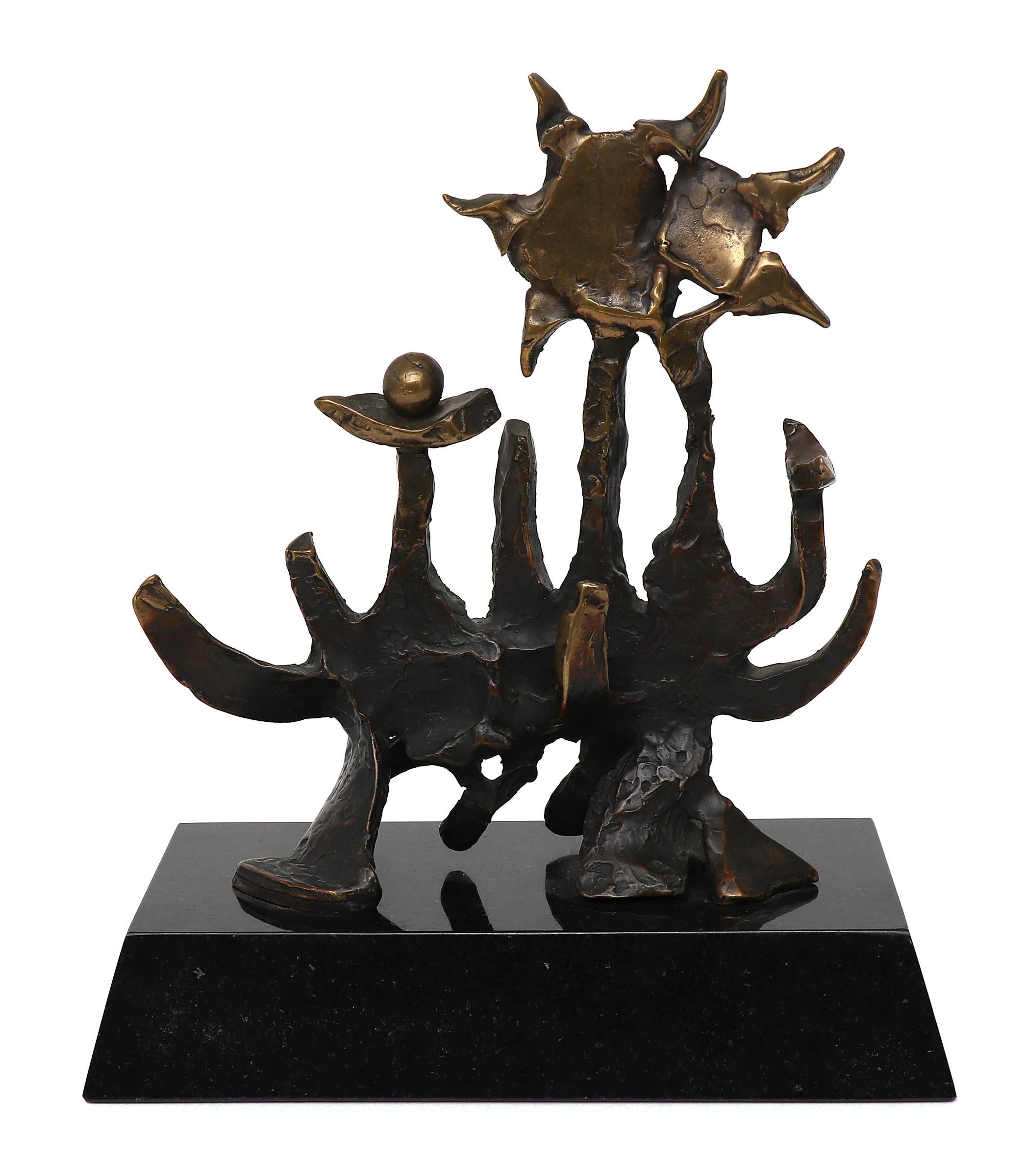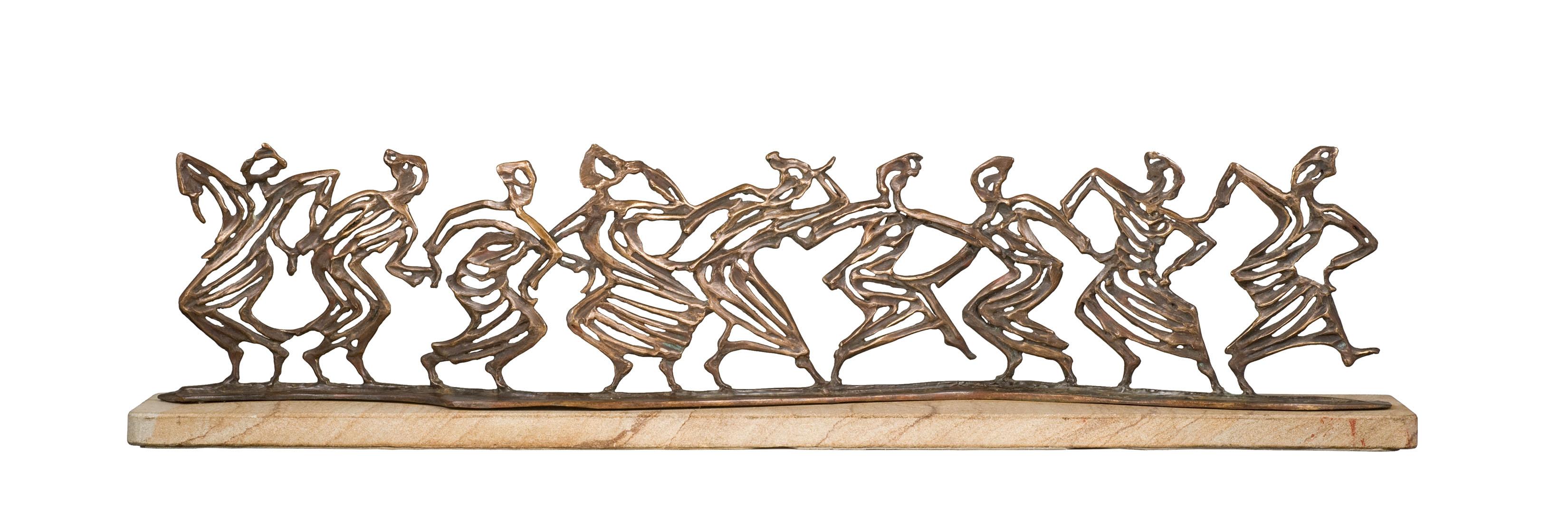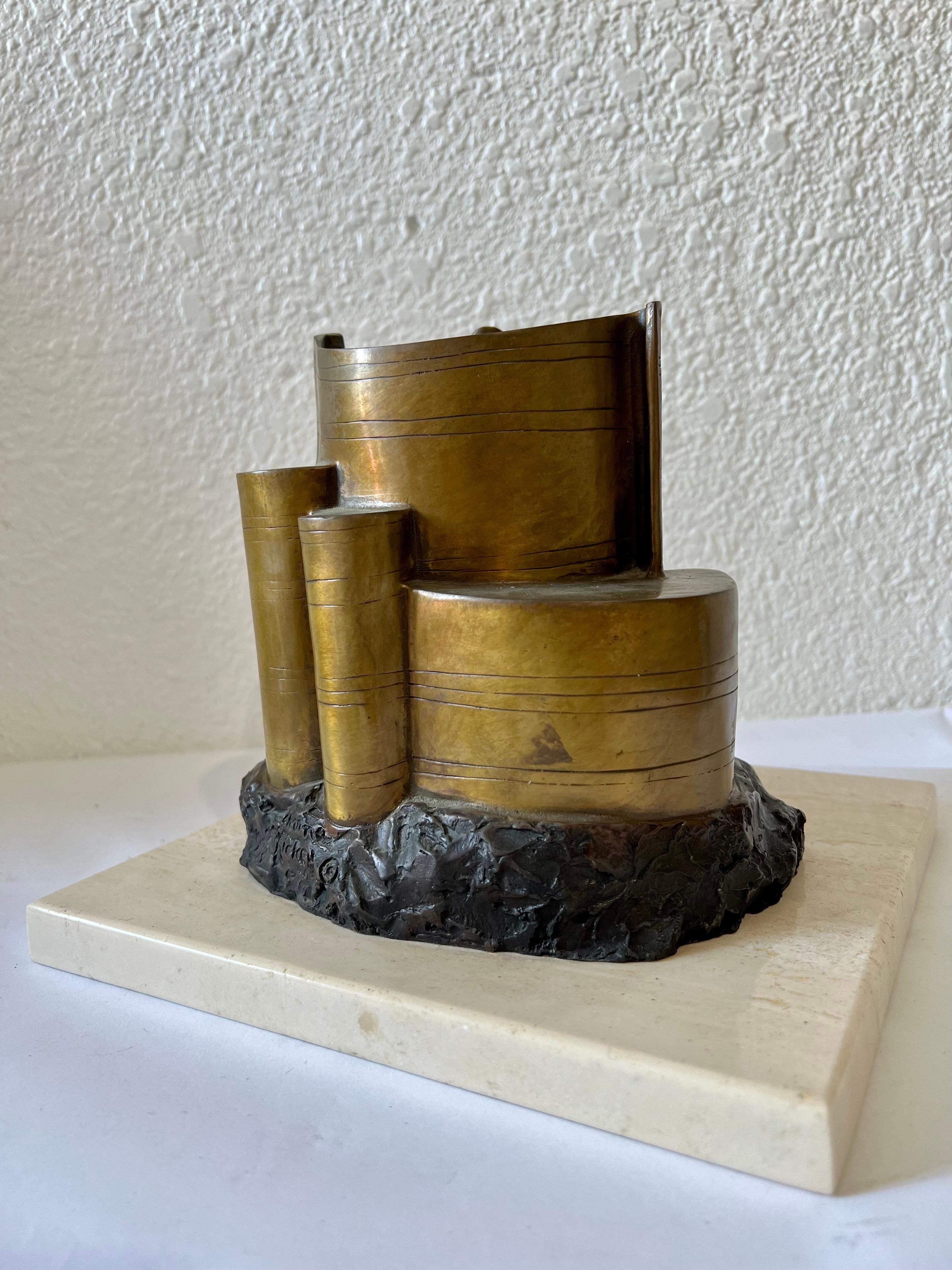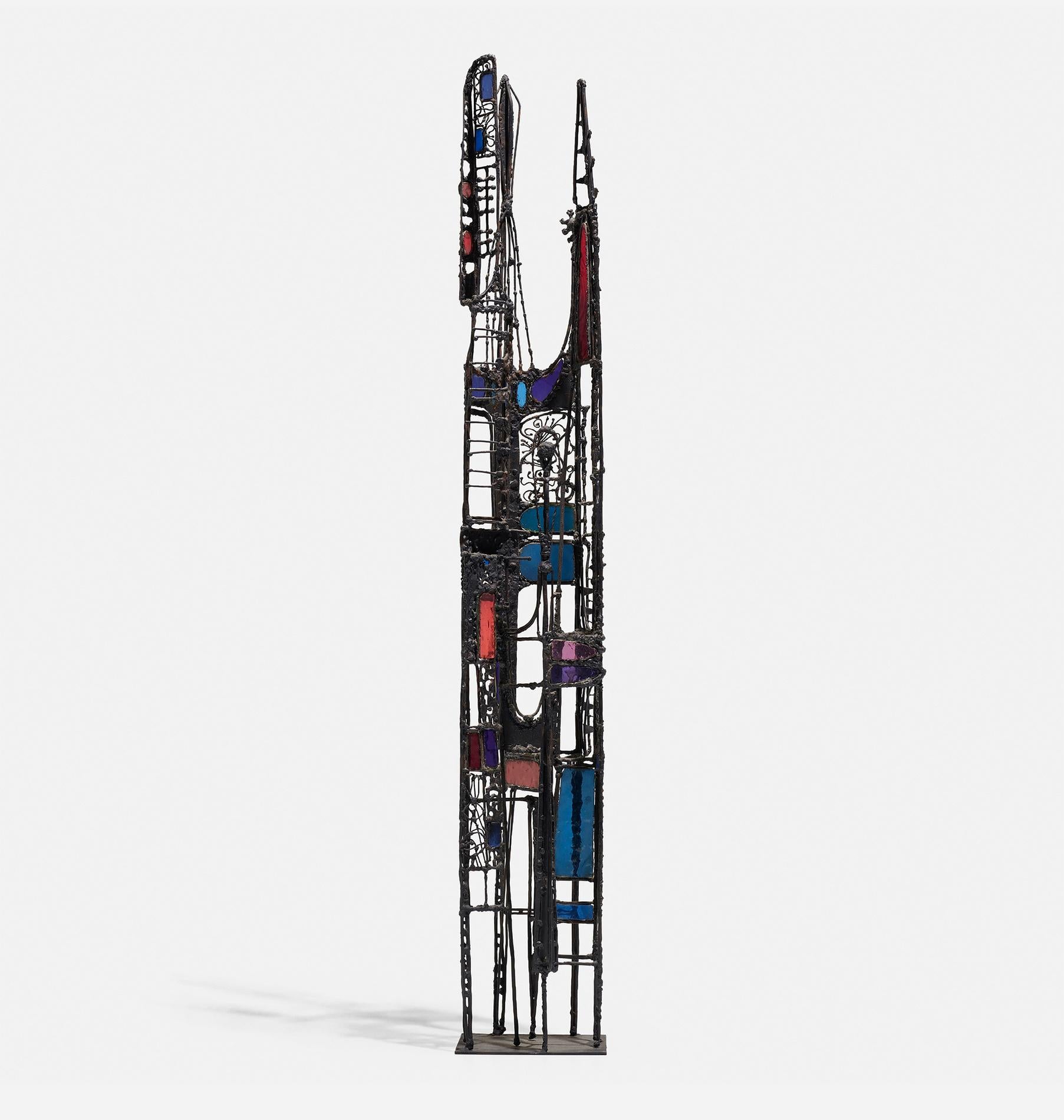Items Similar to Glen Michaels "Winter Wind", Pentaptych Mosaic Stone
Want more images or videos?
Request additional images or videos from the seller
1 of 16
Glen MichaelsGlen Michaels "Winter Wind", Pentaptych Mosaic Stone1970s
1970s
About the Item
SALE ONE WEEK ONLY
This American Modern mosaic abstract sculpture has an extraordinary flow and liquid movement that belies its creation in stone. Its color is in keeping with the title, Winter Wind, a cold gray with sparks of orange and golden sepia.
Michaels passed away in 2020 and was remembered by Cranbrook Art Museum: “Michaels is featured in the upcoming book, With Eyes Opened: Cranbrook Academy of Art Since 1932 (available in 2021) and will have work featured in the accompanying exhibition opening at Cranbrook Art Museum in June 2021. Below is an excerpt from the book, written by Eva Caston.
“Glen Michaels was initially inclined towards a career in music. He played piano for vaudeville shows and won a scholarship to the Yale School of Music in 1950. There he drew caricatures for the school newspaper, painted portraits, and published a book of cartoons entitled Oh, You’re a Musician, which caught the attention of New Yorker cartoonists Mary Petty and Alan Dunn. He went on to receive his BA in arts education from Eastern Washington University in 1957. His teachers at Eastern Washington, Opal Fleckenstein and Frank Okada, alumni of Cranbrook Academy of art, encouraged Michaels to study there.
Cranbrook proved to be a formative environment for Michaels. He arrived as a painter, but soon his fascination with tiles, found objects, and sculpture engendered an aesthetic that exploited the gap between two-dimensional and three-dimensional work. After he graduated, Michaels was hired as a teacher for the Young People’s Art Program, a partnership between the Junior League of Birmingham, Michigan, and Cranbrook Art Museum. He was a leader in the program from 1958 until 1965 and saw it as one of the first initiatives by Cranbrook to be more involved with the local community.
Glen Michaels is a world-renown architectural sculptor from Troy, Michigan, born in Spokane, Washington. He has had works displayed in the Detroit People Mover Bricktown Station, the NASA Goddard Space Flight Center, and the Ford Motor Company 1964 New York World's Fair exhibit (now installed in the Henry Ford Centennial Library). He attended Yale, where he contributed to campus humor magazine The Yale Record.
After he was released from the Army, the GI Bill of Rights gave Michaels the means to study piano at Yale University, but after two years there “I decided I was interested in creating drawings, not music,” he says. He then attended Cranbrook Academy of Art receiving a MFA.
His work can be found at Saint Joseph Mercy Oakland Hospital and Birmingham’s Baldwin Public Library. In 2017 the Scarab Club, the renowned 110-year old artist’s club, gallery and studio located in Midtown Detroit, honored Glen by asking him to sign one of the wooden ceiling beams located in their second floor lounge. Previous signers include Diego Rivera, Norman Rockwell, Eliel Saarinen, Marshall Fredericks, Marcel Duchamp and Balthazar Korab. Michaels was the 2017 recipient of the Birmingham Cultural Arts Award.
- Creator:Glen Michaels
- Creation Year:1970s
- Dimensions:Height: 50 in (127 cm)Width: 66 in (167.64 cm)
- Medium:
- Movement & Style:
- Period:
- Condition:
- Gallery Location:Detroit, MI
- Reference Number:1stDibs: LU128617839202
About the Seller
5.0
Gold Seller
These expertly vetted sellers are highly rated and consistently exceed customer expectations.
Established in 2014
1stDibs seller since 2019
95 sales on 1stDibs
Typical response time: 2 hours
- ShippingRetrieving quote...Ships From: Detroit, MI
- Return PolicyA return for this item may be initiated within 14 days of delivery.
More From This SellerView All
- Magnificent John Glick Plum Street Pottery "Scalloped Box" Glazed StonewareLocated in Detroit, MIThis magnificent "Scalloped Box" is a stoneware piece with decorative layers of rich toned glazes and markings that John was so well-known for. He was, also, known for the undulating lip lines on his exquisite boxes that fit together like a puzzle. Each piece that John produced was unique. He was seduced by the effects of the reduction kiln, which decreased the levels of oxygen during firing, inducing the flame to pull oxygen out of the clay and glazes thereby changing the colors of the glazes depending on their iron and copper content. In this way he achieved the rich gradients of ochre and umber and variations in stippling and opacity. This piece is signed and stamped on the bottom. John was an American Abstract Expressionist ceramicist born in Detroit, MI. Though open to artistic experimentation, Glick was most influenced by the styles and aesthetics of Asian pottery—an inspiration that shows in his use of decorative patterns and glaze choices. He has said that he is attracted to simplicity, as well as complexity: my work continually reflects my re-examination that these two poles can coexist… or not, in a given series. Glick also took influences from master potters of Japan, notably Shoji Hamada and Kanjrio Kawai, blending their gestural embellishments of simple forms with attitudes of Abstract Expressionism. He was particularly drown to the work of Helen Frankenthaler whose soak-stain style resonated with Glick’s multi-layered glaze surfaces, which juxtaposed veils of atmospheric color with gestural marks and pattern. He spent countless hours developing and making his own tools in order to achieve previously unseen results in his work with clay and glaze. Glick’s “Plum Tree Pottery...Category
Late 20th Century American Modern Abstract Sculptures
MaterialsStoneware, Glaze
- Breathtaking John Glick "Scalloped Basket" Glazed Stoneware Reduction FiredLocated in Detroit, MI"Scalloped Basket" is a stoneware piece with the decorative layer of the rich toned glazes and markings that John was so well-known for. He was, also, known for the undulating lip lines on his exquisite pieces. The basket portion is shaped with gentle curves and a sculptural handle. Each piece that John produced was unique. He was seduced by the effects of the reduction kiln, which decreased the levels of oxygen during firing, inducing the flame to pull oxygen out of the clay and glazes changing the colors of the glazes depending on their iron and copper content. In this way he achieved the rich gradients of ochre and umber and variations in stippling and opacity. This particular "basket" also has the cool blues and grays that contrast with the umber. It is signed and stamped on the bottom. John was an American Abstract Expressionist ceramicist born in Detroit, MI. Though open to artistic experimentation, Glick was most influenced by the styles and aesthetics of Asian pottery—an inspiration that shows in his use of decorative patterns and glaze choices. He has said that he is attracted to simplicity, as well as complexity: my work continually reflects my re-examination that these two poles can coexist… or not, in a given series. Glick also took influences from master potters of Japan, notably Shoji Hamada and Kanjrio Kawai, blending their gestural embellishments of simple forms with attitudes of Abstract Expressionism. He was particularly drown to the work of Helen Frankenthaler whose soak-stain style resonated with Glick’s multi-layered glaze surfaces, which juxtaposed veils of atmospheric color with gestural marks and pattern. He spent countless hours developing and making his own tools in order to achieve previously unseen results in his work with clay and glaze. Glick’s “Plum Tree Pottery...Category
1970s American Modern Abstract Sculptures
MaterialsStoneware, Glaze
- John Glick Plum Street Pottery Glazed Bowl Reduction FiredLocated in Detroit, MI"Untitled" is a stoneware piece with the decorative layer of the rich toned glazes and markings that John was so well-known for. Each piece that John produced was unique. The lip on this piece is slightly scalloped and the shape is removed from the boring circular to mimic a gentle geometric design. He was seduced by the effects of the reduction kiln, which decreased the levels of oxygen during firing, inducing the flame to pull oxygen out of the clay and glazes changing the colors of the glazes depending on their iron and copper content. In this way he achieved the rich gradients of ochre and umber and variations in stippling and opacity. This piece is signed and stamped on the bottom. John was an American Abstract Expressionist ceramicist born in Detroit, MI. Though open to artistic experimentation, Glick was most influenced by the styles and aesthetics of Asian pottery—an inspiration that shows in his use of decorative patterns and glaze choices. He has said that he is attracted to simplicity, as well as complexity: my work continually reflects my re-examination that these two poles can coexist… or not, in a given series. Glick also took influences from master potters of Japan, notably Shoji Hamada and Kanjrio Kawai, blending their gestural embellishments of simple forms with attitudes of Abstract Expressionism. He was particularly drown to the work of Helen Frankenthaler whose soak-stain style resonated with Glick’s multi-layered glaze surfaces, which juxtaposed veils of atmospheric color with gestural marks and pattern. He spent countless hours developing and making his own tools in order to achieve previously unseen results in his work with clay and glaze. Glick’s “Plum Tree Pottery...Category
1970s American Modern Abstract Sculptures
MaterialsStoneware, Glaze
- Eugene Caples "Bronze Sculpture II" Abstract Bronze SculptureBy Eugene CaplesLocated in Detroit, MISALE ONE WEEK ONLY This small exquisite "Bronze Sculpture II" is in excellent condition and a perfect example of Eugene Caples craftsmanship. This is mainly abstract with some graphic or architectural elements and is so delightful that mythical creatures demand to be considered. It cries out to be touched and held, looked at and caressed. The beautiful patina on the surface gives voice to the many hands that have done these things. Eugene Caples is a designer and craftsman who worked in Kansas City in the 1960s and later through the early 21st century. He attended the Kansas City Art Institute, earning his Bachelors of Fine Arts in Industrial Design in 1959. In 1963 he was accepted to Cranbrook Academy of Art, Bloomfield Hills, Michigan. The Cranbrook Academy of Art was designed by architect and faculty member, Eliel Saarinen who collaborated with Charles and Ray Eames on chair and furniture design. Numerous creative artists are alumni of Cranbrook and include: Harry Bertoia, Florence Knoll, Jack Lenor Larsen, Donald...Category
Late 20th Century American Modern Abstract Sculptures
MaterialsBronze
- Eugene Caples "Bronze Sculpture I" Abstract Bronze SculptureBy Eugene CaplesLocated in Detroit, MISALE ONE WEEK ONLY This small exquisite "Bronze Sculpture I" is in excellent condition and a perfect example of Eugene Caples craftsmanship. Although it is mainly abstract, there are bits that look figurative either an arm or a leg attempting to emerge from a fold or attempting to hold a pose such as in yoga. It cries out to be touched and held, looked at and caressed. The beautiful patina on the surface gives voice to the many hands that have done these things. Eugene Caples is a designer and craftsman who worked in Kansas City in the 1960s and later through the early 21st century. He attended the Kansas City Art Institute, earning his Bachelors of Fine Arts in Industrial Design in 1959. In 1963 he was accepted to Cranbrook Academy of Art, Bloomfield Hills, Michigan. The Cranbrook Academy of Art was designed by architect and faculty member, Eliel Saarinen who collaborated with Charles and Ray Eames on chair and furniture design. Numerous creative artists are alumni of Cranbrook and include: Harry Bertoia, Florence Knoll, Jack Lenor Larsen, Donald Lipski, Duane Hanson, Nick Cave, Hani Rashid, George Nelson, Urban Jupena (Nationally recognized fiber artist), Artis Lane (the first African-American artist to have her sculpture, "Sojourner Truth," commissioned for the Emancipation Hall in the Capital Visitor Center in Washington DC), Cory Puhlman (televised Pastry Chef extraordinaire), Thom O’Connor (Lithographs), and Paul Evans (Created Brutalist-inspired sculpted metal furnishings.) Gene worked...Category
Late 20th Century American Modern Abstract Sculptures
MaterialsBronze
- "Draped Figure" Sassafras & Bronze, Figurative Sculpture, 1982Located in Detroit, MI"Draped Figure" is a beautiful example of Tazian's ability to meld the smooth texture of wood and the hard texture of bronze into an exquisite object to view, hold or caress. The piece balances perfectly on its stone base and can be easily turned to enjoy from all angles. Like architects Eliel Saarinan and Albert Kahn and sculptor Corrado Parducci, Tazian is an immigrant creative who has found a home in the city, nurtured by its energy and sheltered by its community. He developed an early ambition to become an artist, even though he had very little exposure to the arts. ““The only person [who encouraged me] was my 5th grade English teacher, Olivia Balian,” he says. “She really opened the doors of art for me. She said, ‘Those students who are interested in art can stay behind after school and I will show you how to paint and draw.’ Somehow [that] changed my life– she gave me that spark.” Tazian came to the U.S. to study at St. Francis College in Fort Wayne, Indiana. He earned a bachelor’s degree in art and a Master’s in Art Education, and then earned and MFA in sculpture from Wayne State University in Detroit. Kegham Tazian is an award-winning sculptor and painter. The Armenian-born artist has gained notoriety for the diversity of his work and the variety of media exemplified in his pieces. A blend of modernism, realism and abstraction are commonly depicted in his paintings and sculptures. His artwork has been represented in more than 40 solo exhibitions and more than 75 group exhibitions throughout the United States, Canada, Europe, and the Middle East. His work adorns the entrances and halls of major corporations, universities and municipalities, including Siemens Corporation, Huntington Bank, Wayne State University and the city halls of Farmington and Farmington Hills...Category
21st Century and Contemporary Modern Abstract Sculptures
MaterialsStone, Bronze
You May Also Like
- American Modern Abstract Bronze Sculpture on Granite Stand, Edward ChavezBy Edward Arcenio ChavezLocated in Denver, COAbstract bronze sculpture mounted on granite base by Edward (Eduardo) Arcenio Chavez (1917-1995). Measures 7 ½ x 6 x 2 inches, including stand. Sculpture is in very good to excellent condition - please contact us for a detailed condition report. About the Artist: Born 1917 Died 1995 Born in Wagonmound, New Mexico, Eduardo Chavez...Category
20th Century American Modern Abstract Sculptures
MaterialsGranite, Bronze
- Virasat Curved, figurative bronze mantle pieceBy Robert CookLocated in Greenwich, CTA remarkable and unique format bronze of unique cast that could be great for a mantle or console table. In Robert Cook's book entitled “Waxing and Waning” he discusses three castings...Category
Early 2000s American Modern Abstract Sculptures
MaterialsStone, Bronze
- Bronze Abstract Space Age Book Sculpture LA California Modernist Charna RickeyBy Charna RickeyLocated in Surfside, FLCharna Rickey 1923 - 2000 Mexican-American Jewish Woman artist. Signed Bronze House of Books, Architecture Bronze sculpture, signed Charna Rickey and on the front "House of the book." It depicts an open Torah. Original patina. Approx. dimensions: 7 in. H x 9 in. W x 8.5 in. D. Weight: 13.1 lbs. Modernist Judaica Sculpture Born Charna Barsky (Charna Ysabel or Isabel Rickey Barsky) in Chihuahua, Mexico, the future artist lived in Hermosillo and immigrated to Los Angeles when she was 11. She was educated at UCLA and Cal State L.A., she married furniture retailer David Rickey and explored art while raising their three daughters. Moving through phases in terra cotta, bronze, marble and aluminum, she found success later in life. Rickey became one of the original art teachers at Everywoman's Village, a pioneering learning center for women established by three housewives in Van Nuys in 1963. She also taught sculpture at the University of Judaism from 1965 to 1981. As Rickey became more successful, her sculptures were exhibited in such venues as Artspace Gallery in Woodland Hills and the Courtyard of Century Plaza Towers as part of a 1989 Sculpture Walk produced by the Los Angeles Arts Council. Her sculptures have also found their way into the private collections of such celebrities as Sharon Stone. Another of Rickey's international creations originally stood at Santa Monica College. In 1985, her 12-foot-high musical sculpture shaped like the Hebrew letter "shin" was moved to the Rubin Academy of Music and Dance at Hebrew University in Jerusalem. The free standing architectural Judaic aluminum work has strings that vibrate in the wind to produce sounds. Rickey also created art pieces for the city of Brea. They commissioned some amazing art pieces by Laddie John Dill, Walter Dusenbery, Woods Davy, Rod Kagan, Pol Bury, Niki de Saint Phalle, Magdalena Abakanowicz, Larry Bell, John Okulick...Category
20th Century American Modern Abstract Sculptures
MaterialsMarble, Bronze
- Mid-Century Metal and Colored Glass Sculpture - Like Stained GlassLocated in Miami, FLMid-Century enameled steel, glass sculpture that is visually balanced from 360 degrees. All the positive and negative spaces work in total harmony which is a testament to Samuel Cashwan...Category
1950s American Modern Abstract Sculptures
MaterialsSteel
- The Test, Assembled Kinetic Modernist Sculpture Puzzle ConstructionBy William King (b.1925)Located in Surfside, FL"The Test," 1970 Aluminum sculpture in 5 parts. Artist's cipher and AP stamped into male figure, front, 20 5/16" x 12 1/2" x 6 5/7" (approx.) American sculptor King is most noted for his long-limbed figurative public art sculptures depicting people engaged in everyday activities such as reading or conversing. He created his busts and figures in a variety of materials, including clay, wood, metal, and textiles. William Dickey King was born in Jacksonville, Florida. As a boy, William made model airplanes and helped his father and older brother build furniture and boats. He came to New York, where he attended the Cooper Union and began selling his early sculptures even before he graduated. He later studied with the sculptor Milton Hebald and traveled to Italy on a Fulbright grant. Mr. King worked in clay, wood, bronze, vinyl, burlap and aluminum. He worked both big and small, from busts and toylike figures to large public art pieces depicting familiar human poses — a seated, cross-legged man reading; a Western couple (he in a cowboy hat, she in a long dress) holding hands; a tall man reaching down to tug along a recalcitrant little boy; a crowd of robotic-looking men walking in lock step. Mr. King’s work often reflected the times, taking on fashions and occasional politics. In the 1960s and 1970s, his work featuring African-American figures (including the activist Angela Davis, with hands cuffed behind her back) evoked his interest in civil rights. But for all its variation, what unified his work was a wry observer’s arched eyebrow, the pointed humor and witty rue of a fatalist. His figurative sculptures, often with long, spidery legs and an outlandishly skewed ratio of torso to appendages, use gestures and posture to suggest attitude and illustrate his own amusement with the unwieldiness of human physical equipment. His subjects included tennis players and gymnasts, dancers and musicians, and he managed to show appreciation of their physical gifts and comic delight at their contortions and costumery. His suit-wearing businessmen often appeared haughty or pompous; his other men could seem timid or perplexed or awkward. Oddly, or perhaps tellingly, he tended to depict women more reverentially, though in his portrayals of couples the fragility and tender comedy inherent in couplehood settled equally on both partners. His first solo exhibit took place in 1954 at the Alan Gallery in New York City. King was elected to the American Academy of Arts and Letters in 2003, and in 2007 the International Sculpture Center honored him with the Lifetime Achievement in Contemporary Sculpture Award. Mr. King’s work is in the collections of the Metropolitan Museum of Art, Guggenheim Museum, Whitney Museum and the Museum of Modern Art in New York and the Hirshorn Museum at the Smithsonian American Art Museum in Washington, among other places, and he had dozens of solo gallery shows in New York and elsewhere. Reviews of his exhibitions frequently began with the caveat that even though the work was funny, it was also serious, displaying superior technical skills, imaginative vision and the bolstering weight of a range of influences, from the ancient Etruscans to American folk art to 20th-century artists including Giacometti, Calder and Elie Nadelman. The New York Times critic Holland Cotter once described Mr. King’s sculpture as “comical-tragical-maniacal,” and “like Giacomettis conceived by John Cheever.”Category
1970s American Modern Figurative Sculptures
MaterialsMetal
- Optical ArtLocated in Napoli, ITGio Schiano is a contemporary Italian designer who was born in Naples, Italy in 1976. He is a well-known high fashion photographer as well as a painter, sculptor and designer. Schian...Category
21st Century and Contemporary American Modern Abstract Sculptures
MaterialsPlexiglass




